Butterflies of North America
first update d. 10 December 2015
last update d. 31 December 2022
___________________________________
Western Tiger Swallowtail
Pterourus rutulus
 
Western Tiger Swallowtail, Pterourus
rutulus. Salt Lake City, Utah, USA d. 19 july 2012. Photographer; Carsten Siems
Western Tiger Swallowtail,
Pterourus rutulus (Lucas, 1852) the wings are yellow
with black stripes, and it has blue and orange
spots near its tail. It has the "tails"
on the hind wings that are often found in
swallowtails.
Wingspan: 70
- 100 mm. Females are larger than the small males.
Habitats: is
a common swallowtail butterfly of western North
America, frequently seen in urban parks and
gardens, as well as in rural woodlands and
riparian areas.
Host plants:
Ash, Fraxinus spp. Cottonwood, Populus spp. Willow, Salix spp.
Flight time:
Flying in first generation from February to May,
and several generations to the late autumn.
Distribution:
The normal range of the Western Tiger
Swallowtail covers
much of western North America, from British
Columbia to North Dakota in the north to Baja
California and New Mexico in the south.
Individuals occasionally turn up east of this
range; in eastern North America, though, it is
replaced by the similar Eastern Tiger
Swallowtail, Papilio
glaucus.
|
___________________________________
Eastern Tiger Swallowtail
Pterourus glaucus
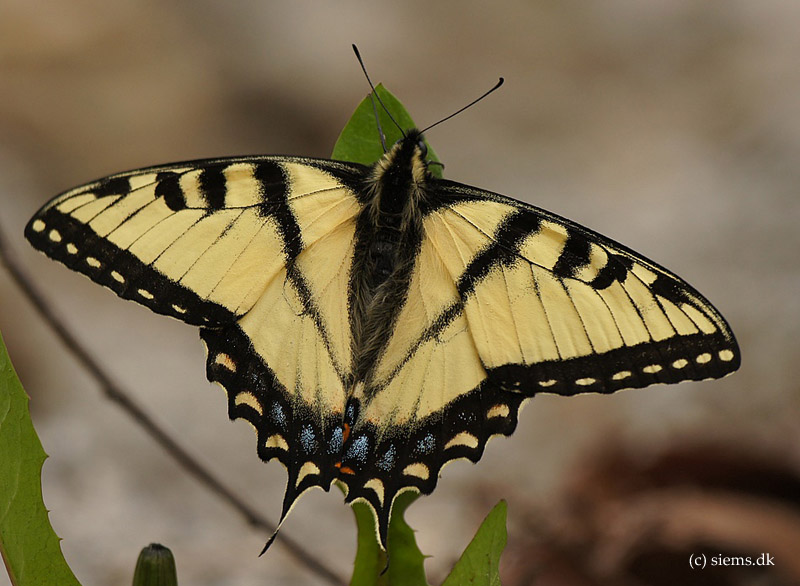
Eastern Tiger Swallowtail, Pterourus
glaucus. Savage River, Maryland, USA d. 30 april 2011. Photographer; Carsten Siems
Eastern Tiger Swallowtail,
Pterourus glaucus (Linnaeus, 1758) the male is
yellow with four black "tiger stripes"
on each fore wing. Females may be either yellow
or black, making them dimorphic. The yellow morph
is similar to the male, but with a conspicuous
band of blue spots along the hindwing, while the
dark morph is almost completely black.
Wingspan: 79
- 140 mm. Females are larger than the small males.
Habitats:
can be found almost anywhere deciduous forests
occur. Common habitats include woodlands, fields,
rivers, creeks, roadsides, and gardens. It will
stray into urban parks and city yards. Because it
has adapted to many different habitats and host
plants, Eastern Tiger Swallowtail is a generalist, and is not
considered threatened.
Host plants:
Wild
black cherry, Prunus
serotina. Ash, Fraxinus spp. Cottonwood, Populus spp. Wafer ash/hop tree, Ptelea trifoliata. Common Lilac, Syinga vulgaris. Sweet bay magnolia, Magnolia virginiana. Tulip poplar/tulip tree, Liriodedron tulipifera. Willow, Salix spp.
Flight time:
Adults are seen from spring to fall, although the
exact date varies depending on the location. In
the south, they are seen from February to
November; in the
north, they are seen from May to September. Eastern
Tiger Swallowtail
produces two broods in the north and three in the
south. The first broods yield the smallest adults.
Distribution:
the Eastern
Tiger Swallowtail is
the state butterfly of Alabama, Delaware, Georgia,
North Carolina, South Carolina and Virginia.
|
___________________________________
Two-tailed Swallowtail
Pterourus multicaudata

Two-tailed Swallowtail, Pterourus multicaudata. North Rim, Grand Canyon,
Arizona d. 7 august 2012. Photographer; Henrik S. Larsen
Two-tailed Swallowtail,
Pterourus multicaudata (W. F. Kirby, 1884) Upper surface
of male forewing are yellow with narrow black
stripes. Each hindwing has 2 tails.
Wingspan: 90
- 127 mm. Females are larger than males.
Habitats:
Foothill slopes and canyons, moist valleys,
streamsides, woodlands, parks, roadsides, suburbs,
and cities.
Behaviour:
Males patrol stream courses or city streets for
receptive females. Are visiting flowers for
nectar as thistles, milkweeds, California buckeye,
lilac, and many others.
Host plants:
Chokecherry, Prunus. Ash, Fraxinus spp. Wafer ash/hop tree, Ptelea trifoliata.
Flight time:
One flight May to mid-August in North, most of
year in South.
Distribution:
Western North America south from British Columbia,
east to central Nebraska and central Texas, south
through Mexico.
|
___________________________________
Gray Hairstreak
Strymon melinus
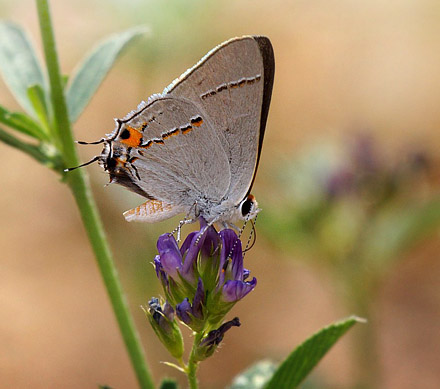
Gray Hairstreak, Strymon
melinus (Hübner, 1818). Salt Lake City, Utah, USA
d.
19 july 2012. Photographer; Carsten Siems
Gray Hairstreak, Strymon
melinus (Hübner, 1818) Upperside blue-gray with large
red spot near the one tail on hindwing. Underside of spring/fall form is
dark gray, summer form is paler gray. Relatively
straight postmedian line is white, bordered with
orange on the inside edge.
Wingspan: 22-35
mm.
Habitats:
can be found on fields, ditches, along small
streams, ruderal, gardens and parks. Because it
has adapted to many different habitats and host
plants, Gray Hairstreak is a generalist, and is not
considered threatened.
Flight time:
two flights from May-September in the north,
three-four flights from February-November in the
south.
Host plants:
flowers and fruits from an almost endless variety
of plants; most often from Beans, Phaseolus. Clovers,
Trifolium. Cotton,
Gossypium and Mallow,
Malva.
Distribution:
throughout continental United States from
southern Canada south to Mexico and Venezuela.
Comments: The most widespread hairstreak in North
America.
|
___________________________________
California Sister
Adelpha californica
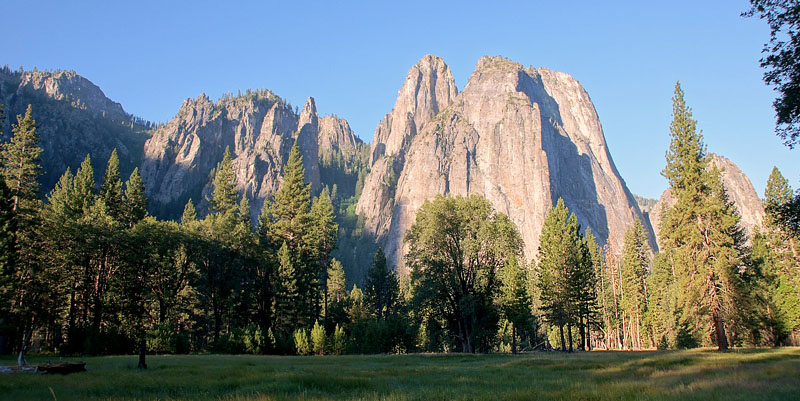 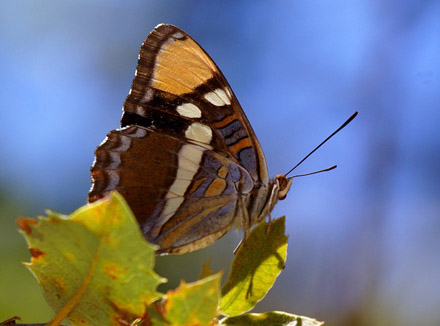 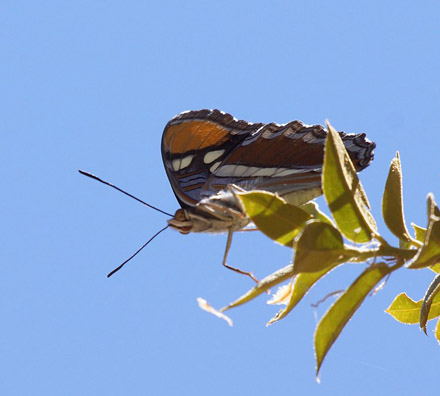
California Sister, Adelpha californica. Yosemite, Californien d. 9 july 2012. Photographer; Carsten Siems
California Sister, Adelpha
californica (Butler, 1865) This is a medium
to large sized brown-black colored butterfly with
a relatively narrow dorsal forewing postdiscal
creamy white colored band above with a relatively
large orange patch on the forewing. Wingspand: 63
- 101 mm.
Habitats:
oak woodlands, Females are highly dispersive and
are most likely to be seen in unusual places. The
species is not a permanent resident in our area
above 1500 m. but is seen regularly up to 2100 m.or
higher in late spring-early summer and again in
autumn.
Adults
visit flowers California Buckeye, Yerba
Santa, Dogbane, Giant
Hyssop, Goldenrod,
Coyotebrush,
but also dung, carrion, flowing sap, damaged
fruit, etc.--a very tropical lifestyle.
Flighttime:
Two to three broods, flying March or April to
November at lower elevations.
Host
plants: oaks, especially Live Oaks, Quercus
agrifolia, Q. wislizenii and Q.
chrysolepis.
Distribution:
in California from northern Baja to western
Nevada and western Oregon, most abundant in the
foothills (Sierra and Coast Range/Bay Area) and
lower montane zone. Uncommon or rare, and
irregular, on the floor of the Central Valley,
but occasionally seen in cities and suburbs.
|
___________________________________
Weidemeyer's Admiral
Limenitis weidemeyerii
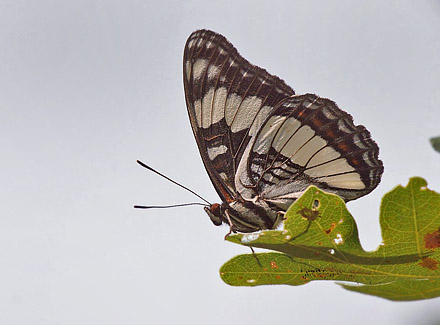
Weidemeyer's Admiral, Limenitis
weidemeyerii. Salt Lake City, Utah, USA d. 19 july 2012. Photographer; Carsten Siems
___________________________________
White Admiral
Limenitis arthemis

White Admiral, Limenitis arthemis (Drury, 1773).
Cape Breton
Highlands National Park, Nova Scotia, Canada d. 27 juli 2007. Photographer; Bjørn Brøndsted
Butterflies and
Moths of North America
___________________________________
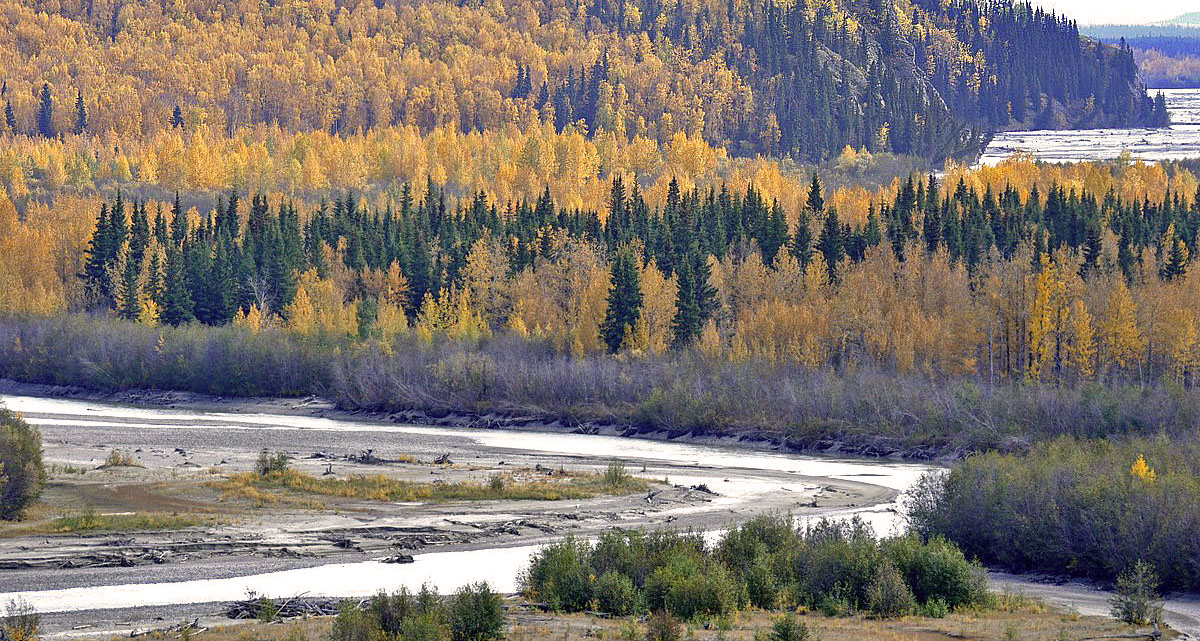 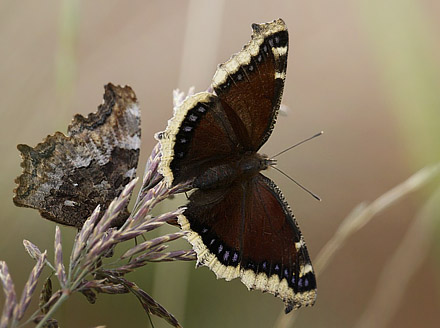 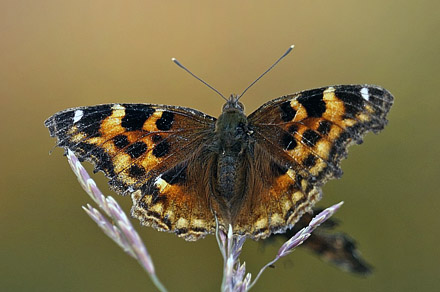 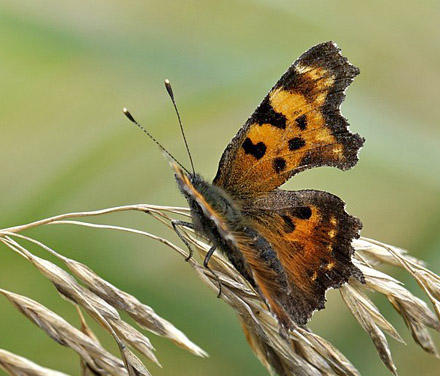
| About
100km south on Fairbanks, Alaska, USA d. 13
september 2014. Photographer; Carsten
Siems |
___________________________________
Ross's Alpine
Erebia rossii
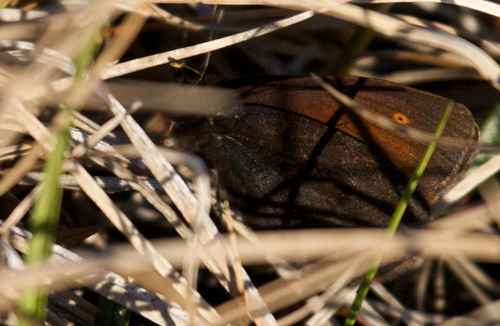
Ross's Alpine, Erebia rossii (Curtis, 1835) Baffin Island,
Arctic Canada d. 30 june 2010. Photographer; Clare Kines
Brigadoon, Baffin Island by Clare Kines
and Iqaluit, Baffin Island.
___________________________________
Butterflies of America and the
Interactive Listing of American Butterflies
Butterflies of North America Paul A. Opler, Ray E. Stanford, and Harry
Pavulaan
Butterflies of Canada
Governement du Canada
___________________________________
BUTTERFLIES from NEARCTIC
&
BUTTERFLIES from BOLIVIA
___________________________________
Home tilbage til forsiden
|














